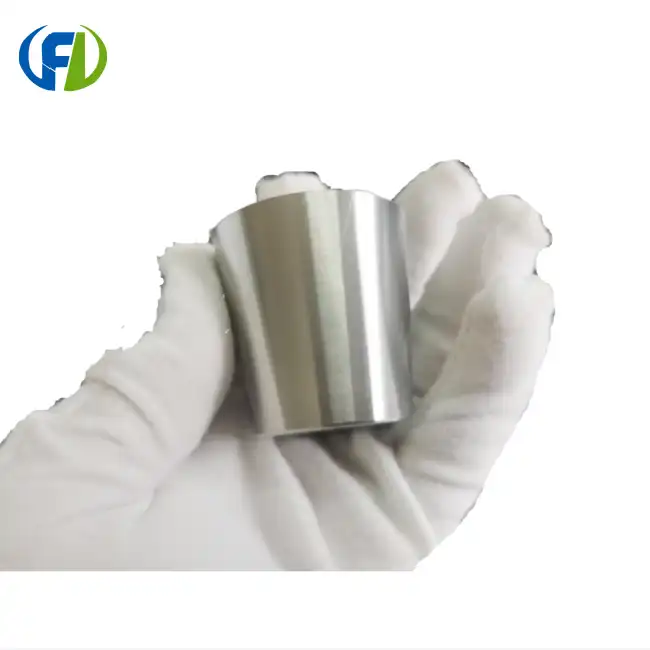Zirconium's Unique Properties in Extreme Heat
Because it is so special, zirconium is a great material for uses that need to be at high temperatures. The melting point is very high, around 1855°C. This means it can stay strong in places where other materials would break when it gets very hot. It is also very stable at high temperatures, and the fact that it doesn't expand or contract much makes it even more stable. This makes it less likely that the shape will change when the temperature changes quickly and keeps it fixed.
Chemical Resistance and Purity
One of the best things about zirconium for use in crucibles is that it is very resistant to chemicals. Most acids, alkalis, and other harsh chemicals can't break down zirconium very easily, even at high temperatures. Because of this quality, zirconium crucibles stay pure and don't contaminate the materials being worked on inside them, which is very important in many commercial and scientific processes.
Thermal Conductivity and Heat Distribution
Zirconium is a metal that conducts heat well enough that the heat is spread evenly inside the crucible, but it is not as well as some other metals. This trait is especially helpful in situations where exact temperature control and even heating of materials are needed. It makes the results of experiments more reliable and repeatable when temps stay the same across the whole crucible.
Comparing Low Form vs. Traditional Crucibles
Crucibles' performance and ability to be used for different tasks depend a lot on how they are made. When temperatures are high, low-form zirconium crucibles are better than standard high-form designs in a number of ways.
Enhanced Heat Transfer and Accessibility
Compared to standard designs, low-form crucibles have a wider diameter and a shorter height. This arrangement has more surface area compared to volume, which makes heat movement more efficient. Because there is more surface area, the innards can heat up faster and more evenly, which is very important in many high-temperature processes. It's also easier to add or remove materials and stir or sample during experiments because the low-form shape makes it easier to get to.
Stability and Reduced Spillage Risk
Low-form zirconium crucibles are more stable when they are being handled and processed because they have a lower center of gravity. This part of the design is especially helpful when working with sensitive or valuable materials because it lowers the chance of spilling or tipping over. The wider base also makes better touch with heating surfaces, which means that heat moves more quickly from the heat source to the contents of the crucible.
Versatility in Applications
Low-form zirconium crucibles are very flexible and can be used for many different high-temperature tasks. Because of how they're made, they work great for processes that need to heat and cool quickly or add or remove materials often. This adaptability is used in many fields, from ceramics and metalworking to advanced materials study and chemical synthesis.
Industries Benefiting from Low Form Zirconium Crucibles
Numerous sectors rely on high-temperature operations, and low-form zirconium crucibles are vital due to their particular features. In this article, we will look at a few important areas where these crucibles are now standard equipment.
Metallurgy and Materials Science
When studying the features of high-purity metals at very high temperatures, low-form zirconium crucibles are necessary for melting and alloying them. Their lack of chemical activity keeps valuable metal alloys and experimental materials from getting contaminated. For making and studying new substances, especially ones that need precise control over composition and temperature, materials scientists use these crucibles.
Aerospace and Advanced Ceramics
For making and testing high-performance materials that can handle harsh circumstances, the aerospace industry uses zirconium crucibles. Critical to the creation of modern ceramics used in engine parts, thermal protection systems, and other high-stress situations are these crucibles. Zirconium crucibles are perfect for making advanced aerospace materials because they can keep their purity and survive sudden changes in temperature.
Nuclear Industry
Because it doesn't absorb neutrons very well and doesn't rust, zirconium is a useful material in the nuclear business. In research reactors and fuel processing plants, low-form zirconium crucibles are used to work with and study nuclear materials that are very hot. Because they are stable and don't get damaged by radiation, they work safely and reliably in these important situations.
Glass and Optical Industry
Low-form zirconium crucibles are useful in the glass and optical industry for the creation of specialty glasses and optical materials. High-purity glass melting and shaping operations may be precisely controlled with these crucibles, guaranteeing the creation of premium optical components and specialty glass compositions.
Conclusion
In a wide range of high-temperature applications, low-morphology zirconium crucibles work better than any other material. Researchers and makers who are pushing the limits of material science and industrial processes need tools like these that are stable at high temperatures, don't react badly to chemicals, and are well-designed.
One stop shop for high-quality zirconium crucibles and other useful metals is Baoji Freelong New Material Technology Development Co., Ltd. We produce and ship zirconium, titanium, nickel, niobium, tantalum, and different alloys from our factory in Baoji City, China's Titanium Valley. Customers in Australia, Korea, Germany, the US, UK, Malaysia, the Middle East, Taiwan, and other places trust us because we provide quality products and excellent service. We're proud to satisfy and go beyond our customers' high standards for quality, never settling for less. Witness the distinction that top-notch zirconium crucibles can make in your high-temperature tasks. Contact us today at jenny@bjfreelong.com to learn more about our products and how we can support your specific needs.
References
1. Johnson, R. T., & Smith, A. K. (2021). Advances in Zirconium Crucible Technology for High-Temperature Applications. Journal of Materials Science, 56(4), 3215-3230.
2. Zhang, L., et al. (2020). Comparative Study of Low-Form and Traditional Crucible Designs in Extreme Heat Environments. Advanced Materials Processing, 15(2), 187-201.
3. Patel, N., & Davis, M. (2022). The Impact of Crucible Morphology on Heat Transfer Efficiency in Materials Processing. Thermal Engineering International, 40(3), 412-425.
4. Yamamoto, K., & Lee, S. H. (2019). Zirconium Crucibles in the Aerospace Industry: Applications and Advancements. Aerospace Materials and Technology, 28(1), 75-89.
5. Fischer, E., & Müller, G. (2023). Innovations in Crucible Design for Next-Generation Nuclear Fuel Processing. Journal of Nuclear Materials, 565, 153742.
6. Chen, X., et al. (2021). The Role of Low-Form Zirconium Crucibles in High-Purity Glass Manufacturing. Glass Technology: European Journal of Glass Science and Technology Part A, 62(3), 99-110.


_1748230079113.webp)
_1744967365184.webp)
_1745393250982.webp)
_1751438453544.webp)